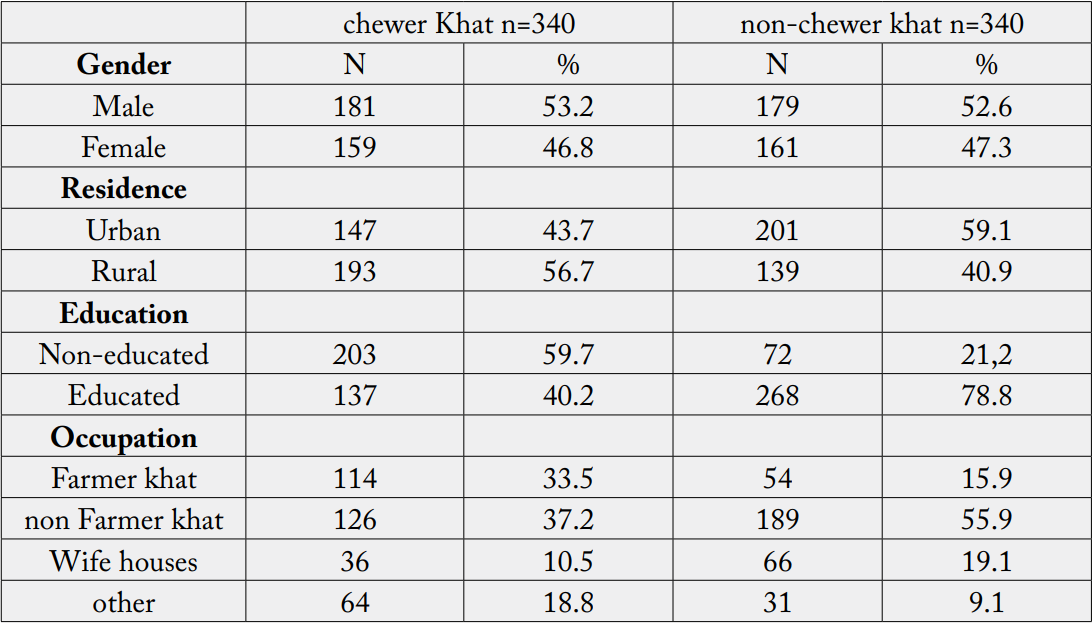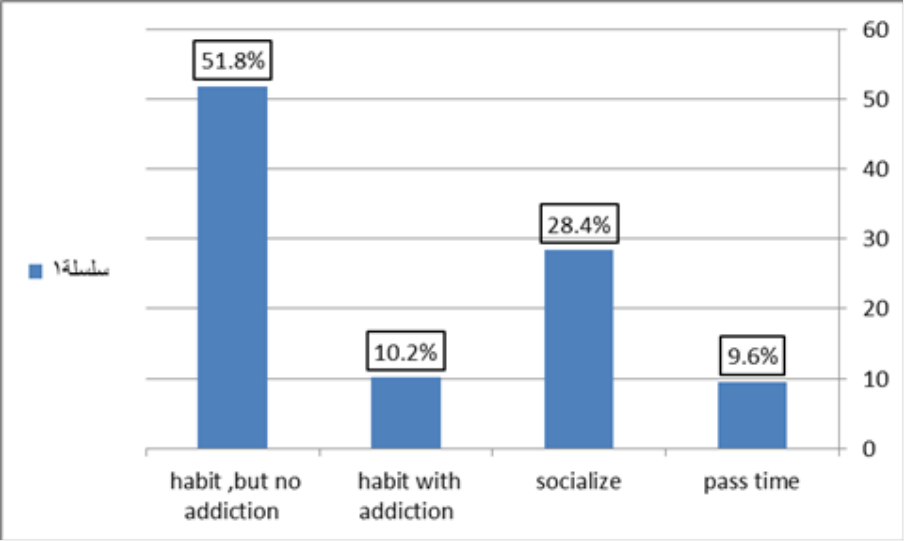Biography
Interests
Abdullah Gafer, A.1 & Mohammed Sadeg Al-Awar, A.2,3*
1Yemeni Ministry of Public Health and Population
2Al-Razi University
3Amran University
*Correspondence to: Dr. Mohammed Sadeg Al-Awar, A., Al-Razi University & Amran University.
Copyright © 2022 Dr. Mohammed Sadeg Al-Awar, et al. This is an open access article distributed under the Creative Commons Attribution License, which permits unrestricted use, distribution, and reproduction in any medium, provided the original work is properly cited.
Abstract
Blood pressure is a major public health problem that contributes significantly to cardiovascular
disease (CVD) morbidity. Worldwide, hypertension affects an estimated 1 billion people, with
65 million adults in the United States. Clinical and statistical research imply that emerging risk
factors for hypertension, such as khat chewing, may exist in addition to traditional risk factors like
dyslipidemia, cigarette smoking, diabetes, and impaired glucose tolerance.
In Yemen, Khat Chewing is a widespread sociocultural practice. It entails inserting a green-leaved plant into the mesiobuccal fold and chewing for several hours. The aim was to determine the prevalence of blood pressure among chewers of khat in Sana’a -Yemen.
A cross-sectional was conducted among khat chewers and non-Khat chewers in Sana’a, Yemen from March -to May 2021. A total of 680 people were included in the study, with an equal proportion
of Khat chewers and non-chewers.
Data were collected by using the semi-structured questionnaire developed from the World Health Organization’s stepwise surveillance tool for chronic disease risk variables (WHO STEPS).
Data coded, entered, and analyzed through SPSS version 25.0 using descriptive and inferential statistics. A two-tailed p-value of less than 0.05 was considered statistically significant.
The findings of the investigation: the prevalence of hypertension was significantly higher among
khat chewers (14.1%) than khat non-chewers (11.5%).
A considerably high proportion of chewers (30.1%) than non-chewers (21.2%) had sub-optimal diastolic blood pressure (> 80 mmHg). Khat chewers had considerably higher mean± SD diastolic blood pressure. [78.8 ±12.2)] than non-chewers [73.9 ±12.9], P < 0.05.
khat chewers had significantly higher mean (sd) heart rate [77.0 ±11.5] than non-chewers [74.9 ±12.3], P < 0.05.
Our study revealed that Khat chewing may contribute to elevated blood pressure, with a more
pronounced effect on diastolic blood pressure. A higher percentage of Khat chewers have sub-optimal DBP. Cathinone may have a long-term effect as a peripheral vasoconstrictor in habitual
Khat chewers.
The correlation between regular Khat chewing and high blood pressure in the general population has serious public health implications.
Khat chewing may have sustained effects on the cardiovascular system that can contribute to elevated blood pressure at the population level.
Introduction
Hypertension is a developing public health issue that contributes significantly to cardiovascular disease
morbidity and mortality. Hypertension is responsible for 7.1 million death per year [1]. In recent years,
significant progress has been made in our understanding of the pathophysiology of vascular disorders and
their consequences [2].
Chewing khat has been shown to have elevated blood pressure and increased heart rate [3].
In Yemen and East Africa, People chew khat for a variety of reasons, including social interaction and the euphoric, energetic, and alerting effects it has on the central nervous system [4,5].
Yemenis consume a lot of khat regularly [6].
The cathinone found in the fresh leaves is primarily responsible for the pharmacological impact of khat chewing [4,5].
Cathinone is a sympathomimetic alkaloid that has catecholamine-releasing characteristics at both central dopaminergic [7] and serotonergic [8].
Cathinone, the active ingredient, raised blood pressure, heart rate, and cardiac contractile force in anesthetized dogs after treatment [3], as well as favorable inotropic and chronotropic effects in isolated atria [9]. Have been reported following the ingestion of cathinone, the active component. In a controlled study, chewing khat increased blood pressure and heart rate, both of which are connected to plasma cathinone levels [10].
In Yemen, there was an elevated incidence of acute myocardial infarction (AMI) Correlation to khat eating. There was also a distinction between the hours of the day and the hours of the night.
AMI presentation pattern among khat users as well as non-khat users [11].
This study was conducted to determine the prevalence of blood pressure among chewers of khat in Sana’a -Yemen.
Methods
A descriptive, cross-sectional study was conducted among Chewer Khat and non-chewer khat in Sana’ a
Governorate from March to May 2021.
Adults between the ages of 35 and 65 who chewed Khat for four or more days per week in the preceding five
years (non-chewers) and those who had never chewed Khat in the previous five years were recruited using
the same procedure.
The sample size was calculated using the usual formula for comparing two means [12].
The sample size was estimated using the source population’s mean blood pressure and standard deviations from a previous study [2]. For estimating the sample size, they were used as a guide
A total of 680 people were included in the study, with an equal proportion of Khat chewers and non-chewers.
To improve data collecting practicality, 45 percent of them were assigned to the urban sample.
Once a home was chosen, all members of the household who met the criteria for either being a Khat chewer or a non-chewer were enrolled in the study.
Adults between the ages of 35 to 65 who chewed Khat for four or more days per week in the previous five
years (chewers) or never chewed Khat in the previous five years (non-chewers)
Adults under the age of 35 were excluded from the study because high blood pressure is less common in this age group.
Pregnant women were excluded from the study due to the potential confounding effect of pregnancy on weight and blood pressure.
The information was gathered using a semi-structured questionnaire developed from the World Health
Organization’s stepwise surveillance tool for chronic disease risk variables (WHO STEPS).
The participant’s blood pressure was taken using Omron M4 digital blood pressure monitoring equipment.
A training document based on the WHO training and practical guide was used to recruit and teach twelve data collectors, six male, and six female, on the administration of survey instruments [13].
Regardless of when Khat was chewed, the interview contacted during the day, between 8:30 a.m. and 6:30 p.m.
Each participant was encouraged to sit and rest for at least five minutes before having their blood pressure measured.
Three measurements were taken on the left arm at 3-5 minute intervals. The average of the second and third assessments was used to define the mean systolic blood pressure (SBP), mean diastolic blood pressure (DBP), and heart rate (HR) of study participants, according to the WHO STEPS approach.
The data was entered and analyzed using the Statistical Package for Social Sciences (SPSS) version 21.0
software. Proportions and percentages were used to describe the characteristics of study participants.
All procedures were carried out in compliance with the institution’s ethical standards, as well as the 1964
Helsinki Declaration and its revisions, or comparable ethical norms.
The study’s purpose and benefits were explained to the participants.
Each study participant gave their informed and written consent.
All participants have the option to refuse to participate or withdraw from the study at any time with no consequences. Individuals with high blood pressure who were identified throughout the survey were recommended to visit a local health facility for a blood pressure measurement.
Results
In this study, 340 people (50.0%) were Khat chewers and 340 people (50.0%) were non-chewers. Of the
Khat chewers, 53.2% were males, 193(56.7%) were rural residents, 203(59.7%) were Non-educated, and
126(37.2%) were non Farmer khat. While Of the Khat non-chewers, 179(52.6%) were males, 201(59.1%)
were urban residents, 268(78.8%) were educated, and 189(55.9%) were non Farmer khat. Table 1.

Causes Chewing Khat among Chewer Khat:
According to the claimed reasons for chewing Khat, 51.8% claim to have a chewing habit, but no addiction,
and believe that they have neither addiction. To pass the time and increase concentration at work, Family
members account for 28.4% of all social interactions. Only 10.2 % of chewers admitted to being addicted
to Khat. Figure1

Hypertension (SBP > 140mmHg or DBP > 90 mmHg) was found to be more common among Khat chewers (14.1%) than among non-chewers (11.5%)
While 36(10.8%) chewer khat was a smoker. Table 2

Table 3 demonstrates the physical differences between Khat chewers and non-chewers. Khat chewers had a substantially higher mean (sd) diastolic blood pressure of 78.8 (12.2) mmHg than non-chewers (73.9 (12.9) mmHg, P< 0.05. Khat chewers had a considerably higher average heart rate per minute.

Discussion
This study compared mean systolic and diastolic blood pressure between adults in Sana’a city who are
Khat chewers and non-chewers. We found a correlation between Khat chewing and mean diastolic blood
pressure, implying that Cathinone has a greater impact on diastolic blood pressure. In earlier studies, chronic
use of Khat has been linked to elevated blood pressure and other cardiovascular diseases [1,14].
Our study was non-similar In the study done by Mossie, in Ethiopia 898 subjects were included, 277 of them were chewers and 621 non-chewers. 29 of the chewers (n=277) and 73 of the non-chewers (n=621) were found to have hypertension. There was no statistically significant difference between chewing Khat and not chewing Khat in this investigation [15].
Our findings are in line with those of earlier studies, that have found a link between Khat chewing and cardiovascular disease morbidity and mortality [2,12,13,16].
Conclusion and Recommendation
Khat chewing, according to our findings, may lead to high blood pressure, with a stronger influence on
diastolic blood pressure. DBP is sub-optimal in a much higher percentage of Khat chewers, Cathinone may
have a long-term effect as a peripheral vasoconstrictor in habitual Khat chewers, according to the research.
The correlation between regular Khat chewing and high blood pressure in the general population has serious
public health implications. To combat the spread of Khat chewing and other substance use habits, programs
for the prevention and control of high blood pressure in the community must create solutions.
Bibliography

Hi!
We're here to answer your questions!
Send us a message via Whatsapp, and we'll reply the moment we're available!